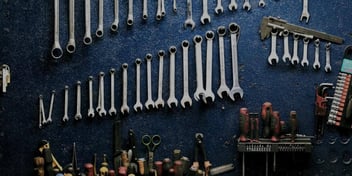It might be tempting to reach for a knife or other small tool to help unwrap presents during the holidays, but doing so may lose you some family time to an unexpected hospital visit. And if you want to decorate your home or office, you’ll want to make sure you’re prepared for safety.
According to OSHA, the greatest hazards involved with hand tools result from misuse and improper maintenance (source). Power tools tend to pose more obvious threats, and there are many required and recommended safety measures associated with them.
Make sure your employees know how to handle tools properly to ensure a safe work environment. Though large equipment might seem like a more threatening problem, effective training on the safe use of hand and power tools is equally as important.
What Are The Hazards?
Hand tools in need of repair or replacement create hazards. Tools with wooden handles, like hammers and axes, can splinter or break in the middle of use, resulting in injury. Impact tools like chisels are unsafe for use if they have “mushroomed” heads because they could shatter on impact and cause injury.
Power tools with damaged cords or other damaged parts pose serious risks. Anything that can fall off or come loose during operation is unsafe to use. Employees should make sure that all tools are in acceptable condition before using them. An easy way to remind them of this is to post little reminders near toolboxes and workstations—seeing these reminders often on the job will keep tool safety on their minds.
Ensure Safety With Proper Use
Only use hand and power tools for their intended purpose, and always follow proper safety procedures. This includes any safety guards, physical barriers, and personal protective equipment. Using the wrong tool for the job is a sure way to cause injury, ruin the tools, and possibly ruin whatever you’re working on.
Set up a safe environment by never removing safety guards or other precautionary measures. When using power tools with cords, make sure your employees are aware of where the cord is and keep it tucked out of the way when possible. Cords can get in the way and, if damaged, can cause harm.
Regular Maintenance Is Key
All tools should be regularly inspected to make sure they’re in good working condition. Any wooden tools that begin to break or splinter should be repaired or replaced. Blades of all types should be kept sharp—dull blades can actually be more dangerous than sharp ones. All hand and power tools can become dangerous with missing or broken parts. Don’t wait until something breaks to fix it.
Small tools can create big problems. Inform your employees today to keep them safe and to keep business flowing. Check out these convenient training materials from Ving that cover all the basics of hand and power tool safety.






Leave a Comment